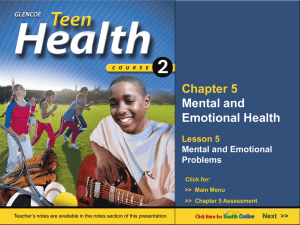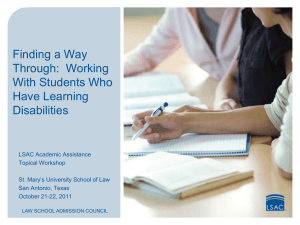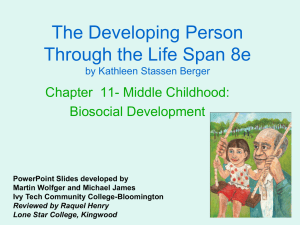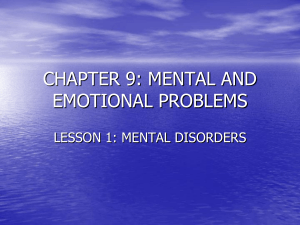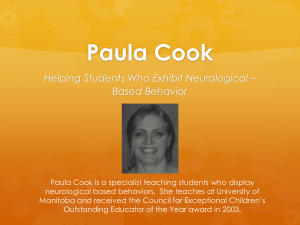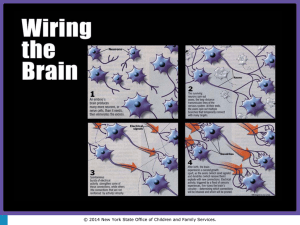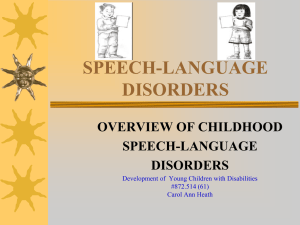Understanding The DSM-5 Implications for Juvenile
advertisement
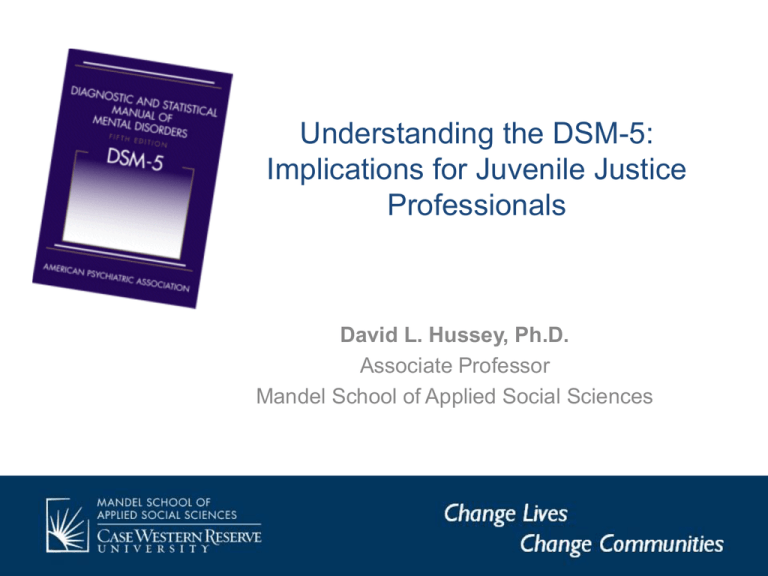
Understanding the DSM-5: Implications for Juvenile Justice Professionals David L. Hussey, Ph.D. Associate Professor Mandel School of Applied Social Sciences Abstract • This seminar will review changes found in the new DSM-5, specifically focusing on those diagnoses that pertain to children and adolescents. Attendees will become familiar with the major structural and organizational changes to DSM-5, and be exposed to the critical disorder-specific diagnostic changes most likely to intersect and impact the work of juvenile justice professionals. Elements of Diagnosis • Diagnostic Criteria and Descriptors • Subtypes and Specifiers • Medication-Induced Movement Disorders & Other Conditions That May be the Focus of Clinical Attention • Principal Diagnosis DSM History • • • • • • • • 1952: The DSM-I 1968: The DSM-II 1974: The DSM-II Reprint 1980: The DSM-III 1987: The DSM-III-R 1994: The DSM-IV 2000: The DSM-IV-TR 2013: The DSM-5 Guiding Principles for New DSM-5 Disorders • Research evidence should support any addition or substantive modification. • Continuity with the current manual should be maintained when possible. • Routine clinical practices must be able to implement any changes. • No restraints should limit the degree of change between DSM-5 and past editions. DSM-5 Organization: Three Sections • Section I: DSM-5 Basics – Introduction, Use of the Manual, Cautionary Statement for Forensic Use. • Section II: Diagnostic Criteria and Codes – 20 Chapters; Medication-Induced Movement Disorders and Other Adverse Effects of Medication; Other Conditions that May Be a Focus of Clinical Attention. • Section III: Emerging Measures and Models – Assessment Measures, Cultural Formulation, Alternative DSM-5 Model for Personality Disorder, Conditions for Further Study. • Appendix: Highlights of Changes from DSM-IV to DSM-5, Glossary of Technical Terms, Glossary of Cultural Concepts of Distress, Alphabetical Listing of DSM-5 Diagnoses and Codes (ICD-9-CM and ICD-10-CM), Numerical Listing of DSM-5 Diagnoses and Codes (ICD-9-CM), Numerical Listing of DSM-5 Diagnoses and Codes (ICD-10-CM), Advisors and Other Contributors. DSM-IV Flaws • DSM-IV compartmentalizes diagnoses into strict categories that do not reflect the most common symptom patterns that actually appear in patients. – High rates of co-occurrence – Frequent use of the NOS designation – Heterogeneous mix of conditions Dimensional Approach • Restructuring of diagnostic groups thought to be biologically related under the same headings. • Multiple-gene susceptibility findings lend further support to a reorganization of DSM that moves away from a strict, categorical, “yes/no” approaches. • Incorporation of dimensional measures for assessing syndromes within broad diagnostic categories and supraordinate dimensions that cross current diagnostic boundaries. • Consider distinctive aspects that differ significantly within a disorder (such as symptom severity; acute or chronic), as well as the presence of symptoms that are outside the “pure” disorder definitions (such as anxiety and somatic symptom levels for patients with depression). • Help reduce the need for multiple diagnoses, provides background explanation for an NOS diagnosis, clarifies the presence and severity of individual symptoms and informs treatment planning. • Recognizes presence of overlapping conditions (bipolar disorder and schizophrenia) DSM-5 Chapters • • • • • • • • • • • • • • • • • • • • Neurodevelopmental Disorders Schizophrenia Spectrum and Other Psychotic Disorders Bipolar and Related Disorders Depressive Disorders Anxiety Disorders Obsessive-Compulsive and Related Disorders Trauma- and Stressor-Related Disorders Dissociative Disorders Somatic Symptom Disorders Feeding and Eating Disorders Elimination Disorders Sleep-Wake Disorders Sexual Dysfunctions Gender Dysphoria Disruptive, Impulse Control and Conduct Disorders Substance Use and Addictive Disorders Neurocognitive Disorders Personality Disorders Paraphilic Disorders Other Disorders Neurodevelopmental Disorders • • • • Intellectual Disabilities Communication Disorders Autism Spectrum Disorder Attention-Deficit/Hyperactivity Disorder minor wording changes. – Addition of criteria for Attention-Deficit/Hyperactivity Disorder Not Elsewhere Classified • Specific Learning Disorder • Motor Disorder • Other Neurodevelopmental Disorders Attention-Deficit/Hyperactivity Disorder (ADHD) • ADHD placed in neurodevelopmental disorders chapter. • Examples have been added to the criterion items to facilitate application across the life span. • The cross-situational requirement has been strengthened to “several” symptoms in each setting. • The onset criterion has been changed from “symptoms that caused impairment were present before age 7 years” to “several inattentive or hyperactive-impulsive symptoms were present prior to age 12.” • Subtypes have been replaced with presentation specifiers that map directly to the prior subtypes. • A comorbid diagnosis with autism spectrum disorder is now allowed. • A symptom threshold change has been made for adults, to reflect their substantial evidence of clinically significant ADHD impairment, with the cutoff for ADHD of five symptoms, instead of six required for younger persons, both for inattention and for hyperactivity and impulsivity. ADHD ADHD Changes • Clustered within Neurodevelopmental Disorders • Cross-cutting measures • Six changes: – Elimination of the DSM-IV subtypes with their replacement as specifiers of current presentation – Reduction of symptom threshold for ADHD in adults – Raising age at onset – Requirement for multiple informants – Removal of autism and PDD from the exclusionary criteria (permitting ADHD in presence of ASD) – Elaboration of examples of symptoms to provide behavioral descriptions for older adolescents and adults ADHD: DSM-IV Criteria • Symptom threshold: More than 6 of 9 symptoms of inattention or more than 6 of 9 symptoms of hyperactivity– impulsivity, persisting for at least 6 months, that are maladaptive and developmentally inconsistent • Age of onset: Some symptoms causing impairment were present before age 7 • Pervasiveness of symptoms: Present in 2 or more settings • Impairment: Social, academic, or work • Exclusionary disorders: ADHD was not diagnosed in the presence of autistic disorder or pervasive developmental disorder (PDD) Schizophrenia Spectrum and Other Psychotic Disorders • • • • • • • • • • • • Schizotypal (Personality) Disorder Delusional Disorder Brief Psychotic Disorder Schizophreniform Disorder Schizophrenia Schizoaffective Disorder Substance/Medication-Induced Psychotic Disorder Psychotic Disorder Due to Another Medical Condition Catatonia Associated with Another Mental Disorder Catatonic Disorder Due to Another Medical Condition Unspecified Catatonia Other Specified Schizophrenia Spectrum and Other Psychotic Disorder • Unspecified Schizophrenia Spectrum and Other Psychotic Disorder Schizophrenia Spectrum and Other Psychotic Disorders • Reorganization of the disorders within this category to reflect a gradient of psychopathology, from least to most severe. • Schizoaffective Disorder - updated rationale for proposed changes to this disorder. • Other Specified Schizophrenia Spectrum and Other Psychotic Disorder (new). • Unspecified Schizophrenia Spectrum and Other Psychotic Disorder renamed from Psychotic Disorder Not Otherwise Specified. • Psychotic Disorder Due to Another Medical Condition renamed from Psychotic Disorder Associated With a Known General Medical Condition. • Updated severity dimensions for these disorders. Bipolar & Related Disorders • • • • (continued) Bipolar I Disorder Bipolar II Disorder Cyclothymic Disorder Substance/Medication -Induced Bipolar Disorder • Bipolar & Related Disorder Due to Another Medical Condition • Other Specified Bipolar and Related Disorder • Unspecified Bipolar and Related Disorder Depressive Disorders • • • • • Disruptive Mood Dysregulation Disorder Major Depressive Disorder Persistent Depressive Disorder (Dysthymia) Premenstrual Dysphoric Disorder Substance/Medication-Induced Depressive Disorder • Depressive Disorder Due to Another Medical Condition • Other Specified Depressive Disorder • Unspecified Depressive Disorder Depressive Disorders • DSM-5 contains several new depressive disorders, including disruptive mood dysregulation disorder and premenstrual dysphoric disorder. • Dysthymia in DSM-IV now falls under the category of Persistent Depressive Disorder, which includes both chronic major depressive disorder and the previous dysthymic disorder. Disruptive Mood Dysregulation Disorder (DMDD) • For children ages 6-10. • Characterized by “temper outbursts are manifest verbally and/or behaviorally in the form of verbal rages, or physical aggression towards people or property.” Disruptive Mood Dysregulation Disorder A.Severe recurrent temper outbursts manifested verbally (e.g., verbal rages) and/or behaviorally (e.g., physical aggression toward people or property) that are grossly out of proportion in intensity or duration to the situation or provocation. B.Temper outbursts are inconsistent with developmental level. C.The temper outbursts occur, on average, three or more times per week. D.The mood between temper outbursts is persistently irritable or angry most of the day, nearly every day, and is observable by others (e.g., parents, teachers, peers). E.Criteria A-D have been present for 12 or more months. Throughout that time the individual has not had a period lasting 3 or more consecutive months without all the symptoms in Criteria A-D. F.Criteria A and D are present in at least two of three settings (i.e., at home, at school, with peers) are are severe in at least one of these. Disruptive Mood Dysregulation Disorder(continued) G. The diagnosis should not be made for the first time before age 6 years or after age 18 years. H. By history or observation, the age at onset of Criteria A-E is before 10 years. I. There has never been a distinct period lasting more than 1 day during which the full symptom criteria, except duration, for a manic or hypomanic episode have been met. Note: Developmentally appropriate mood elevation, such as occurs in the context of a highly positive event or its anticipation, should not be considered as a symptom of mania or hypomania. Disruptive Mood Dysregulation Disorder(continued) J. The behaviors do not occur exclusively during an episode of major depressive disorder and are not better explained by another mental disorder (e.g., autism spectrum disorder, PTSD, separation anxiety disorder, persistent depressive disorder (dysthymia). Note: This diagnosis cannot coexist with oppositional defiant disorder, intermittent explosive disorder, or bipolar disorder, though it can coexist with others, including major depressive disorder, ADHD, conduct disorder, and substance use disorders. Individuals whose symptoms meet criteria for both disruptive mood dysregulation disorder and oppositional defiant disorder should only be given the diagnosis of disruptive mood dysregulation disorder. If an individual has ever experienced a manic or hypomanic episode, the diagnosis of disruptive mood dysregulation disorder should not be assigned. K. The symptoms are not attributable to the physiological effects of a substance or another medical or neurological condition. MDD Specifiers • Specify course • Specify severity • Specify with: anxious distress, mixed features, atypical features, psychotic features, catatonia, peripartum, seasonal pattern. Specifiers for Depressive Disorder and Suicide Risk Assessment • DSM-5 embrace a slightly more formal process for assessing suicidal risk. • A new specifier to indicate the presence of mixed symptoms has been added across both the bipolar and the depressive disorders, allowing for the possibility of manic features in individuals with a diagnosis of unipolar depression. Persistent Depressive Disorder A.This disorder represents a consolidation of DSM-IV-defined chronic major depressive disorder and dysthymic disorder. 1. Depressed mood most of the day, for more days than not, as indicated by either subjective account or observation by others for at least 2 years. Note: In children and adolescents, mood can be irritable and duration must be at least one year. 2. Presence, while depressed, of two (or more) of the following: 1. 2. 3. 4. 5. 6. Poor appetite or overeating. Insomnia or hypersomnia. Low energy or fatigue. Low self-esteem. Poor concentration or difficulty making decisions Feelings of hopelessness. Persistent Depressive Disorder (continued) C. D. E. F. G. H. During the 2-year period (1 year for children or adolescents) of the disturbance, the individual has never been without the symptoms in Criteria A an dB for more than 2 months at a time. Criteria for a major depressive disorder may be continuously present for 2 years. There has never been a manic episode or a hypomanic episode, and criteria have never been met for cyclothymic disorder. The disturbance is not better explained by a persistent schizoaffective disorder, schizophrenia, delusional disorder, or other specified or unspecified schizophrenia spectrum or other psychotic disorder. The symptoms are not attributable to the physiological effects of a substance (e.g., a drug of abuse, a medication) or another medical condition (e.g., hypothyroidism). The symptoms cause clinically significant distress or impairment in social, occupational, or other important areas of functioning. Anxiety Disorders • Anxiety Disorders are now being broken into three groups: Anxiety Disorders; Trauma-Related Disorders; Obsessive Compulsive-Related Disorders. • Changes in criteria for agoraphobia, specific phobia, and social anxiety disorder include deletion of the requirement that individuals over age 18 years recognize that their anxiety is excessive or unreasonable. • Panic Attack terminology simplified (expected, unexpected) and can be listed as an applicable specifier to all DSM-5 disorders. • Panic Disorder and Agoraphobia unlinked, each with separate criteria. Agoraphobia requires endorsement of fears from 2 or more agoraphobic situations. Anxiety Disorders • • • • • • • • • • • • Separation Anxiety Disorder Selective Mutism Specific Phobia Social Anxiety Disorder (Social Phobia) Panic Disorder Panic Attack Specifier Agoraphobia Generalized Anxiety Disorder Substance/Medication-Induced Anxiety Disorder Anxiety Disorder Due to Another Medical Condition Other Specified Anxiety Disorder Unspecified Anxiety Disorder Anxiety Disorders: Overview of Changes • • • • • • Broken down into three groups: Anxiety Disorders; Trauma-Related Disorders; Obsessive Compulsive-Related Disorders. Specific Phobia & Social Anxiety Disorder include deletion of requirement that individuals >18 recognize their anxiety is excessive or unreasonable. Panic Attack – Now listed as a specifier (not codable) applicable to all DSM5 disorders. Panic disorder (PD) and agoraphobia are unlinked. PD with agoraphobia, PD without agoraphobia, and agoraphobia without a history of panic disorder are now replaced by two diagnoses, panic disorder and agoraphobia, each with separate criteria. The “generalized” specifier for social anxiety disorder and been deleted and replaced with a “performance only” specifier. Separation anxiety and selective mutism are now classified as anxiety disorders. The wording of the criteria is modified to more adequately represent the expression of separation anxiety symptoms in adulthood. Also, in contrast to DSM-IV, the diagnostic criteria no longer specify that onset must be before age 18 years, and a duration statement – “typically lasting for 6 months or more” – has been added for adults to minimize over diagnosis of transient fears. Obsessive-Compulsive and Related Disorders • • • • • • Obsessive Compulsive Disorder Body Dysmorphic Disorder Hoarding Disorder Trichotillomania Excoriation (Skin Picking Disorder) Substance-Induced Obsessive-Compulsive and Related Disorders • Obsessive-Compulsive and Related Disorder Due to Another Medical Condition • Other Specified Obsessive-Compulsive and Related Disorder • Unspecified Obsessive-Compulsive and Related Disorder Trauma-and Stressor-Related Disorders • Reactive Attachment Disorder • Disinhibited Social Engagement Disorder • Posttraumatic Stress Disorder • Acute Stress Disorder • Adjustment Disorders • Other Specified Trauma- and StressorRelated Disorders • Unspecified Trauma- and Stressor-Related Disorders Trauma- and Stressor- Related Disorders • Posttraumatic Stress Disorder - wording changes (e.g., adding “directly” in criterion A1). • PTSD in preschool children proposed as a subtype of PTSD instead of a separate diagnosis. • Specifier whether with dissociative symptoms. • Acute Stress Disorder - minor wording changes. • Addition of criteria for Persistent Complex Bereavement Disorder (Section III). • Addition of criteria for Unspecified Trauma- or Stressor- Related Disorders. Disruptive, Impulse-Control, and Conduct Disorders • New chapter brings together disorders that were previously included in the chapter “Disorders Usually First Diagnosed in Infancy, Childhood, or Adolescence” all characterized by problems in emotional and behavioral self-control. Because of its close association with conduct disorder (and substance related and addictive disorders), antisocial personality disorder has dual listing in this chapter and in the chapter on personality disorders. • Oppositional Defiant Disorder. Symptoms are now grouped into three types: angry/irritable mood, argumentative/defiant behavior, and vindictiveness. – Exclusion criterion for conduct disorder has been removed. – A note has been added to the criteria to provide guidance on the frequency typically needed for a behavior to be considered symptomatic. – A severity rating has been added to the criteria to reflect research showing the degree of pervasiveness of symptoms across settings. • Conduct Disorder. A descriptive features specifier has been added for individuals who meet full criteria for the disorder but also present with limited prosocial emotions. Oppositional Defiant Disorder A. A pattern of angry/irritable mood, argumentative/defiant behavior, or vindictiveness lasting at least 6 months as evidenced by at least four symptoms from any of the following categories, and exhibited during interaction with at least one individual who is not a sibling: Angry/Irritable Mood 1. 2. 3. Often loses temper. Is touchy or easily annoyed. Is often angry and resentful. Argumentative/Defiant Behavior 4. 5. 6. 7. Often argues with authority figures or, for children and adolescents, with adults. Often actively defies or refuses to comply with requests from authority figures or with rules. Often deliberately annoys others. Often blames others for his or her mistakes or behavior. Vindictiveness 8. Has been spiteful or vindictive at least twice within the past 6 months. Disruptive, Impulse-Control, and Conduct Disorders • Intermittent Explosive Disorder. Types of aggressive outbursts include physical aggression (required in DSM-IV) as well as verbal aggression and nondestructive/noninjurious physical aggression. – DSM-5 also provides more specific criteria defining frequency needed to meet criteria and specifies that the aggressive outbursts are impulsive and/or anger based in nature, and must cause marked distress, cause impairment in occupational or interpersonal functioning, or be associated with negative financial or legal consequences. – A minimum age of 6 years (or equivalent developmental level) is now required. – For youth, the relationship of this disorder to other disorders (e.g., ADHD, disruptive mood dysregulation disorder) has been further clarified. Intermittent Explosive Disorder A. Recurrent behavioral outburst representing a failure to control aggressive impulses as manifested by either of the following: 1. 2. B. C. Verbal aggression (e.g., temper tantrums, tirades, verbal arguments or fights) or physical aggression toward property, animals, or other individuals, occurring twice weekly, on average, for a period of 3 months. The physical aggression does not result in damage or destruction of property and does not result in physical injury to animals or other individuals. Three behavioral outbursts involving damage or destruction of property and/or physical assault involving physical injury against animals or other individuals occurirng within a 12-month period. The magnitude of aggressiveness expressed during the recurrent outbursts is grossly out of proportion to the provocation or to any precipitating psychosocial stressors. The recurrent aggressive outbursts are not premeditated (i.e., they are impulsive and/or anger-based) and are not committed to achieve some tangible objective (e.g., money, power, intimidation). Intermittent Explosive Disorder(continued) D. The recurrent aggressive outbursts cause either marked distress in the individual or impairment in occupational or interpersonal functioning, or are associated with financial or legal consequences. E. Chronological age is at least 6 years (or equivalent developmental level) F. The recurrent aggressive outbursts are not better explained by another mental disorder (e.g., major depressive disorder, bipolar disorder, disruptive mood dysregulation disorder, a psychotic disorder, antisocial personality disorder, borderline personality disorder) and are not attributable to another medical condition (e.g., head trauma, Alzheimer’s disease) or to the physiological effects of a substance (e.g., drug of abuse, a medication. For children ages 6 -18 years, aggressive behavior that occurs as part of an adjustment disorder should not be considered for this diagnosis. Note: This diagnosis can be made in addition to the diagnosis of attentiondeficit/hyperactivity disorder, conduct disorder, oppositional defiant disorder, or autism spectrum disorder when recurrent impulsive aggressive outbursts are in excess of those usually seen in these disorders and warrant independent clinical attention. Conduct Disorders A. A repetitive and persistent pattern of behavior in which the basic rights of others and major age-appropriate societal norms or rules are violated as manifested by the presence of at least three of the following 15 criteria in the past 12 months from any of the categories below, with at least one criterion present in the past 6 months: Three behaviors must be present in the last 12 months with at least one present in the last six months. Aggression to People and Animals 1. Often bullies, threatens, or intimidates others. 2. Often initiates physical fights. 3. Has used a weapon that can cause serious physical harm to others (e.g., a bat, brick, broken bottle, knife, gun). 4. Has been physically cruel to people. 5. Has been physically cruel to animals. 6. Has stolen while confronting a victim (e.g., mugging, purse snatching, extortion, armed robbery). 7. Has forced someone into sexual activity. Conduct Disorders (continued) Destruction of Property 8. Has deliberately engaged in fire setting with the intention of causing serious damage. 9. Has deliberately destroyed others' property (other than by fire setting). Deceitfulness or theft 10. Has broken into someone else's house, building or car. 11. Often lies to obtain goods or favors to avoid obligations (i.e. "cons" others. 12. Has stolen items of nontrivial value without confronting a victim (i.e. shoplifting, but without breaking and entering; forgery). Conduct Disorders (continued) Serious Violations of Rules 13. Often stays out at night despite parental prohibitions beginning before age 13 years. 14. Has run away from home overnight at least twice while living in parental or parental surrogate home, or once without returning for a lengthy period. 15. Is often truant from school, beginning before age 13 years. B. The disturbance in behavior causes clinically significant impairment in social, academic, or occupational functioning. C. If the individual is age 18 years of older, criteria are not met for antisocial personality disorder. Substance Use & Addictive Disorders • Criteria in the chapter no longer include dependence and abuse as separate entities; abuse, dependence, and addiction are viewed as one continuous variable with severity based on number of endorsed criteria. • Craving has been added to criteria, and recurrent legal difficulties has been eliminated. • The threshold for diagnosis of substance-related and addictive disorders is two or more criteria, in contrast to a threshold of one or more criteria for a diagnosis of DSM-IV substance abuse and three or more for DSM-IV substance dependence. • The DSM-IV specifier for a physiological subtype has been eliminated. • Newly named: Hallucinogen Disorder; Sedative/Hypnotic-Related Disorders; Stimulant Disorders. Cannabis Withdrawal is new for DSM-5, as is Caffeine Withdrawal. • Gambling Disorder is included in DSM-5, replacing pathological gambling in the “Impulse-Control Disorders Not Elsewhere Classified” section of earlier editions. Substance Use and Addictive Disorders (continued) • • • • • • • • • • • • • • Chapter order and numbering designations have been reorganized according to substance (whereas these were previously organized according to the diagnosis). Hallucinogen Disorders have now subsumed Phencyclidine Disorders. Sedative/Hypnotic-Related Disorders renamed from Sedative, Hypnotic, or Anxiolytic Disorders. Stimulant Disorders renamed from Amphetamine and Cocaine Disorders. Updated the Severity Specifiers. Updated the Remission Specifiers. Removal of Substance-Induced Dissociative Disorder. Minor wording changes to most of the criteria. Addition of criteria for Hallucinogen Persisting Perception Disorder. Addition of criteria for Caffeine Use Disorder. Addition of criteria for Cannabis Withdrawal. Addition of criteria for Neurobehavioral Disorder Associated With Prenatal Alcohol Exposure - proposed for Section III. Addition of criteria for Internet Gaming Disorder - proposed for Section III. Addition of criteria for Drug Specific "Not Elsewhere Classified" diagnoses. Cannabis Use Disorder A. A problematic pattern of cannabis use leading to clinically significant impairment or distress, as manifested by at least two of the following occurring within a 12-month period: 1. 2. 3. 4. 5. 6. 7. 8. 9. Cannabis is often taken in larger amounts or over a longer period than was intended. There is a persistent desire or unsuccessful efforts to cut down or control cannabis use. A great deal of time is spent in activities necessary to obtain cannabis, use cannabis, or recover from its effects. Craving, or a strong desire or urge to use cannabis. Recurrent cannabis use resulting in a failure to fulfill major role obligations at work, school, or home. Continued cannabis use despite having persistent or recurrent social or interpersonal problems caused or exacerbated by the effects of cannabis. Important social, occupational, or recreational activities are given up or reduced because of cannabis use. Recurrent cannabis use in situations in which it is physically hazardous. Cannabis use is continued despite knowledge of having a persistent or recurrent physical or psychological problem that is likely to have caused or exacerbated by cannabis. Cannabis Use Disorder (Criteria A continued) 10. Tolerance, as defined by either of the following: a. b. A need for markedly increased amounts of cannabis to achieve intoxication or desired effect. Markedly diminished effect with continued use of the same amount of cannabis. 11. Withdrawal, as manifested by either of the following: a. b. The characteristic withdrawal syndrome for cannabis (refer to Criteria A and B of the criteria set for cannabis withdrawal). Cannabis (or a closely related substance) is taken to relieve or avoid withdrawal symptoms. Gambling Disorder A. Persistent and recurrent problematic gambling behavior leading to clinically significant impairment or distress, as indicated by the individual exhibiting 4 (or more) of the following in a 12-month period: 1. 2. 3. 4. 5. 6. 7. 8. 9. Needs to gamble with increasing amounts of money in order to achieve the desired excitement. Is restless or irritable when attempting to cut down or stop gambling. Has made repeated unsuccessful efforts to control, cut back, or stop gambling. Is often preoccupied with gambling (e.g., having persistent thoughts of reliving past gambling experiences, handicapping or planning the next venture, thinking of ways to get money with which to gamble). Often gambles when feeling depressed (e.g., helpless, guilty, anxious, depressed). After losing money gambling, often returns another day to get even (“chasing one’s losses). Lies to conceal the extent of involvement with gambling. Has jeopardized or lost a significant relationship, job, or educational or career opportunity because of gambling. Relies on others to provide money to relieve desperate financial situations caused by gambling. Personality Disorders • Problems with existing DSM-IV classification include – High rates of co-morbidity between disorders – Extreme heterogeneity – Lack of synchrony with medicine – Poor convergent validity Types of Personality Disorders • Personality disorders that are odd or eccentric (Cluster A, paranoid, schizoid, schizotypal); dramatic, erratic, and labile (Cluster B, histrionic, narcissistic, antisocial, and borderline), and disorders where individuals are fearful, inhibited, and anxious (Cluster C, avoidant, dependent, obsessive-compulsive, and NOS categories such as depressive personality disorder or passiveaggressive). Paraphilic Disorders • Are all paraphilias ipso facto mental disorders? – A paraphilia is a necessary but not a sufficient condition for having a paraphilic disorder. • Criterion A specifies the qualitative nature of the paraphilia and Criterion B specifies the negative consequences of the paraphilia. Paraphilic Disorders (continued) • All Paraphilic Disorders now include two new specifiers: In a Controlled Environment and In Remission. • Paraphilias chapter renamed Paraphilic Disorders. • Hypersexual Disorder - proposed for Section III, but eventually excluded. • Paraphilic Coercive Disorder - proposed for Section III but eventually excluded. Paraphilic Disorders (types) • Voyeuristic Disorder • Exhibitionistic Disorder • Frotteuristic Disorder • Sexual Masochism Disorder • Sexual Sadism Disorder Paraphilic Disorders • • • • • (types continued) Pedophilic Disorder Fetishistic Disorder Transvestic Disorder Other Specified Paraphilic Disorder Unspecified Paraphilic Disorder Other Conditions that May Be A Focus of Clinical Attention • • • • • • • • Relational Problems Abuse & Neglect Problems Educational and Occupational Problems Housing and Economic Problems Other Problems Related to Social Environment Problems Related to Crime or Interaction with Legal System Other Health Service Encounters for Counseling and Medical Advice Problems Related to Other Psychosocial, Personal, and Environmental Circumstances • Other Circumstances of Personal History • Problems Related to Access to Medical and Other Health Care Section III Emerging Measures and Models • Assessment measures • Guidance on cultural formulation • Alternative model for diagnosing personality disorders • Conditions for further study Assessment • Patient Assessment Measures (“emerging”) – – – – – – – Level I Cross-Cutting Measures Level II Cross-Cutting Measures Disorder-Specific Severity Measures Disability Measures Personality Inventories Early Development and Home Background Cultural Formulation Interviews • http://www.psychiatry.org/practice/dsm/dsm 5/online-assessment-measures Section III: Personality Disorders • • • • Several proposed revisions were drafted proposing significant changes, however, the APA ultimately decided to retain the same 10 personality disorders. Early complex versions attempted to replace rigid categories with a trait-specific method (symptoms indicate traits ranked by severity) and an alternative hybrid dimensional-categorical model included in a separate chapter in Section III of DSM-5. The hybrid model includes evaluation of impairments in personality functioning (how an individual typically experiences himself or herself as well as others) plus five broad areas of pathological personality traits. Each type is defined by a specific pattern of impairments and traits. The Alternate DSM-5 model retains six personality disorder types: – Borderline Personality Disorder – Obsessive-Compulsive Personality Disorder – Avoidant Personality Disorder – Schizotypal Personality Disorder – Antisocial Personality Disorder – Narcissistic Personality Disorder This approach also includes a diagnosis of Personality Disorder—Trait Specified (PDTS). Section III: Personality Disorders (continued) • Criterion A: Level of Personality Functioning. Disturbances of self and interpersonal functioning are evaluated on a continuum. Self functioning involves identity and self –direction; interpersonal functioning involves empathy and intimacy. The Level of Personality Functioning Scale (LPFS) uses these elements to differentiate 5 levels of impairment: no impairment (0) to extreme (4). • Criterion B: Pathological Personality Traits. 5 broad domains: Negative Affectivity, Detachment, Antagonism, Disinhibition, and Psychoticism, and 25 specific trait facets (subsets applied to different personality disorders). General Criteria for Personality Disorder The essential features of a personality disorder are: A. Moderate or greater impairment in personality (self/interpersonal) functioning. B. One or more pathological personality traits. C. The impairments in personality functioning and the individual’s personality trait expression are relatively inflexible and pervasive across a broad range of personal and social situations. D. The impairments in personality functioning and the individual’s personality trait expression are relatively stable across time, with onsets that can be traced back to at least adolescence or early adulthood. E. The impairments in personality functioning and the individual’s personality trait expression are not better explained by another mental disorder. F. The impairments in personality functioning and the individual’s personality trait expression are not solely attributable to the physiological effects of a substance or another medical condition (e.g., severe head trauma). G. The impairments in personality functioning and the individual’s personality trait expression are not better understood as normal for an individual’s developmental stage or sociocultural environment. DSM-5 Alternative Model of Personality Disorders Personality Disorder Types -Borderline Personality Disorder -Obsessive-Compulsive Personality Disorder -Avoidant Personality Disorder -Schizotypal Personality Disorder -Antisocial Personality Disorder -Narcissistic Personality Disorder Core Functional Impairments Self Identity Self-Direction Interpersonal Empathy Intimacy Personality Disorder Trait Domains (Polar Opposites) & Facets Negative Affectivity (vs. Emotional Stability) – 9 Facets Detachment (vs. Extroversion) – 6 Facets Antagonism (vs. Agreeableness) – 6 Facets Disinhibition (vs. Consciousness) – 5 Facets Psychoticism (vs. Lucidity) – 3 Facets Section III: Antisocial Personality Disorder A. Moderate or greater impairment in personality functioning, manifested by characteristic difficulties in two or more of the following areas: 1. Identity: Egocentrism; self-esteem derived from personal gain, power, or pleasure. 2. Self-direction: Goal setting based on personal gratification; absence of prosocial internal standards, associated with failure to conform to lawful or culturally normative ethical behavior. 3. Empathy: Lack of concern for feelings, needs, or suffering of others; lack of remorse after hurting or mistreating another. 4. Intimacy: Incapacity for mutually intimate relationships, as exploitation is a primary means of relating to others, including by deceit and coercion; use of dominance or intimidation to control others. B. Six or more of the following seven pathological personality traits: 1. Manipulativeness (an aspect of Antagonism): Frequent use of subterfuge to influence or control others; use of seduction, charm, glibness, or ingratiation to achieve one’s ends. Attention seeking (an aspect of Antagonism): Excessive attempts to attract and be the focus of attention of others; admiration seeking. 2. Callousness (an aspect of Antagonism): Lack of concern for feelings or problems of others; lack of guilt or remorse about the negative or harmful effects of one’s actions on others; aggression; sadism. Section III: Antisocial Personality Disorder 1. 2. 3. 4. 5. (continued) Deceitfulness (an aspect of Antagonism): Dishonesty and fraudulence; misrepresentation of self; embellishment or fabrication when relating events. Hostility (an aspect of Antagonism): Persistent or frequent angry feelings; anger or irritability in response to minor slights and insults; mean, nasty, or vengeful behavior. Risk taking (an aspect of Disinhibition): Engagement in dangerous, risky, and potentially self-damaging activities, unnecessarily and without regard for consequences; boredom proneness and thoughtless initiation of activities to counter boredom; lack of concern for one’s limitations and denial of the reality of personal danger. Impulsivity (an aspect of Disinhibition): Acting on the spur of the moment in response to immediate stimuli; acting on a momentary basis without a plan or consideration of outcomes; difficulty establishing and following plans. Irresponsibility (an aspect of Disinhibition): Disregard for—and failure to honor— financial and other obligations or commitments; lack of respect for—and lack of follow-through on—agreements and promises.



